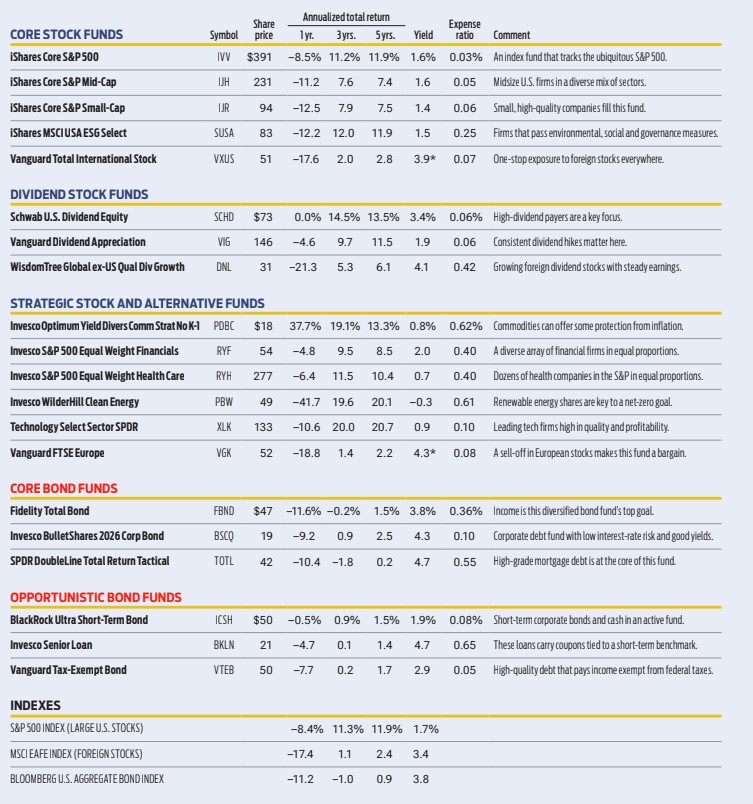Kip ETF 20: What's In, What's Out and Why
The broad market has taken a major hit so far in 2022, sparking some tactical changes to Kiplinger's lineup of the best low-cost ETFs.


These days, checking on how your investments are doing feels a little like asking for a hard punch in the gut. Nearly every major asset class has suffered losses in recent months. It has been a total disaster.
Over the past six months, the S&P 500 Index surpassed the 20%-loss threshold that typically defines a bear market, though it recovered some. The bond market, which is supposed to provide ballast in a portfolio in times like these, is suffering its own rout. The Bloomberg U.S. Aggregate Bond Index is down 9.2%. Foreign stocks have spiraled down, too. The MSCI EAFE Index, the traditional benchmark for foreign stocks in developed countries, slipped 19.2%; the MSCI Emerging Markets Index fell 17.1%.
It's in this environment that we conduct our annual review of the Kiplinger ETF 20, our favorite exchange-traded funds, and the ETF industry as a whole. As you can imagine, there's little green – as in positive gains – to be found among our Kip ETF 20. It's a sea of red. But losses are an inevitable fact of investing. "This is part of the price of admission," says Ben Johnson, head of global ETF research at Morningstar, the financial data firm. "If it's too hard to watch, then step out and look at the trees, which at this time of year are mostly green, unlike the markets."
From just $107.88 $24.99 for Kiplinger Personal Finance
Become a smarter, better informed investor. Subscribe from just $107.88 $24.99, plus get up to 4 Special Issues

Sign up for Kiplinger’s Free Newsletters
Profit and prosper with the best of expert advice on investing, taxes, retirement, personal finance and more - straight to your e-mail.
Profit and prosper with the best of expert advice - straight to your e-mail.
We don't make changes to our Kiplinger ETF 20 roster lightly. But in order to make room for tactical strategies, something had to come out. This year, we made three such changes; a fourth change was related to an underperforming fund.
What's In, What's Out and Why
We're removing the Fidelity MSCI Industrials Index ETF (FIDU). Stocks in this sector thrive in the early-to-mid part of the economic cycle, but we're now firmly in the late stage, likely heading toward a recession. That said, if you own shares in this fund, stick with it. In a well-diversified portfolio, some parts will work when others do not.
However, we wanted to make room for a new strategy – a commodities fund, the Invesco Optimum Yield Diversified Commodity Strategy No K-1 ETF (PDBC). Commodities are in year three of a positive cycle, and such cycles typically last more than a dozen years, say strategists at Wells Fargo Investment Institute. Commodities are effective inflation foils and good portfolio diversifiers, too; when other assets are in decline, commodities tend to do well.
On the bond side, the value in municipal bonds was too good to overlook. Returns are down this year for all major muni-bond categories. But the selloff has created opportunities unseen in years, says a recent report from the Schwab Center for Financial Research. Most municipal bonds pay interest that is exempt from federal taxes. That benefit, coupled with rising yields, means that on a tax-equivalent basis, muni bonds currently yield as much or more than Treasuries and corporate debt.
For that reason, we are replacing the Vanguard Total International Bond ETF (BNDX), which currently yields 2.1%, with the Vanguard Tax-Exempt Bond ETF (VTEB), which pays a tax-equivalent yield of 3.8% for investors in the 24% federal income tax bracket.
We're also swapping out the Vanguard Intermediate-Term Bond ETF (BIV) for an investment-grade corporate bond fund with a target maturity, the Invesco BulletShares 2026 Corporate Bond ETF (BSCQ). The Vanguard ETF is solid, but BulletShares 2026 Corporate Bond offers better reward for the risk. Its duration (a measure of interest-rate sensitivity) is 3.8 years, but it yields 4.3%. By contrast, the Vanguard ETF has a duration of 6.5 years and yields 3.8%.
For the extra yield in the BulletShares fund, you give up a little in credit quality. The fund's bonds have an average credit rating of triple-B, the lowest rung of investment-grade credit. The Vanguard ETF, on the other hand, has an average credit quality of double-A. But over the past 12 months, the BulletShares ETF has lost 9.2%; the Vanguard fund, 12.1%.
A Few Words About Ark Innovation
The ARK Innovation ETF (ARKK), which invests in "innovation that's going to change lives," says manager Cathie Wood, is now the poster child for fizzled-out growth funds.
All of the fund's 35 stocks – which Wood had identified as the best ideas in an array of future trends, including DNA sequencing and gene therapies, energy storage, and robotic and artificial intelligence – are down since the start of the year. The ETF has plummeted 62% over the past 12 months. Readers who bought the fund when we added it to the Kip ETF 20 in 2019 were able to experience outsize gains in 2020, so their losses aren't quite as severe: The fund has posted a meager 0.8% cumulative gain since we added it to the Kip ETF 20 in mid 2019.
What went wrong? Investors spurned shares in fast-growing, nascent businesses as worries about inflation, rising interest rates and lofty valuations overran promises of future growth. "This is risk-off behavior," says manager Wood. Investors sought safety instead in well-known, profitable benchmark stocks, she says. "Most of the names in our portfolios are not in the broad-based Indexes. This is a continuation of fears around inflation and interest rates. It started a year ago, and it remains the case today."
Many of the companies in Ark Innovation's portfolio will likely survive a recession, if one arrives, including Exact Sciences (EXAS), the maker of at-home colon cancer tests; semiconductor leader Nvidia (NVDA); and Teladoc Health (TDOC). Indeed, most of the fund's top 10 holdings, which make up 61% of the portfolio, pull in billions of dollars in annual revenue; half are profitable, including Tesla (TSLA) and Zoom Video Communications (ZM).
But others may not survive an economic downturn. The fund has a good share of smaller positions in companies that are not profitable. Annual revenues at a handful of these companies come in under $100 million. That's a risk with a recession looming. And it's hard to see the market bottom from here; shares look likely to fall further.
So we're removing Ark Innovation from the Kip ETF 20. When we added the fund, we cautioned readers that this was a "shoot-the-moon investment, not a core holding." A long-term view and an iron stomach are necessary if you invest in this type of fund. Even Wood says she invests with a five-year time horizon in mind.
If you sized your investment appropriately with that in mind, the fund accounts for a tiny slice of your overall portfolio, and you could hang on to your shares. Eventually, growth stocks will come back, and by holding on you'd avoid locking in losses. "If you believe in the long-term growth of these trends, then this could be a blip," says Todd Rosenbluth, head of research at ETF data and analytics firm VettaFi, who adds he's not "for or against" the ETF. "If you don't believe in the long-term trends, then it's not the right fund for you."
But if you unload your Ark Innovation shares, it may pay to wait for a bear-market rally before you sell. These sharp, short-term stock-price rebounds that occur during a broader and longer market decline tend to be fast and ferocious, so be on the lookout.
We are replacing Ark Innovation with the Technology Select Sector SPDR Fund (XLK), a tech fund that invests in more-established companies.
The Kiplinger ETF 20 at a Glance

Profit and prosper with the best of Kiplinger's advice on investing, taxes, retirement, personal finance and much more. Delivered daily. Enter your email in the box and click Sign Me Up.

Nellie joined Kiplinger in August 2011 after a seven-year stint in Hong Kong. There, she worked for the Wall Street Journal Asia, where as lifestyle editor, she launched and edited Scene Asia, an online guide to food, wine, entertainment and the arts in Asia. Prior to that, she was an editor at Weekend Journal, the Friday lifestyle section of the Wall Street Journal Asia. Kiplinger isn't Nellie's first foray into personal finance: She has also worked at SmartMoney (rising from fact-checker to senior writer), and she was a senior editor at Money.
-
 I'm feeling down since my grandkids left after the holidays.
I'm feeling down since my grandkids left after the holidays.We asked therapists for advice on how grandparents can handle the post-holiday blues.
-
 5 Golden Rules We (Re)learned in 2025 About Investing
5 Golden Rules We (Re)learned in 2025 About InvestingSome investing rules are timeless, and 2025 provided plenty of evidence demonstrating why they're useful. Here's a reminder of what we (re)learned.
-
 How to Earn a Fistful of Interest on Your Cash in 2026
How to Earn a Fistful of Interest on Your Cash in 2026Is your cash earning very little interest? With rates dropping below 4%, now is the time to lock in your cash strategy. Just watch out for the tax implications.
-
 Dow Hits a Record High After December Jobs Report: Stock Market Today
Dow Hits a Record High After December Jobs Report: Stock Market TodayThe S&P 500 also closed the week at its highest level on record, thanks to strong gains for Intel and Vistra.
-
 Nasdaq Takes a Hit as the Tech Trade Falters: Stock Market Today
Nasdaq Takes a Hit as the Tech Trade Falters: Stock Market TodayThe Dow Jones Industrial Average outperformed on strength in cyclical stocks.
-
 Dow Hits New High Then Falls 466 Points: Stock Market Today
Dow Hits New High Then Falls 466 Points: Stock Market TodayThe Nasdaq Composite, with a little help from tech's friends, rises to within 300 points of its own new all-time high.
-
 Dow, S&P 500 Rise to New Closing Highs: Stock Market Today
Dow, S&P 500 Rise to New Closing Highs: Stock Market TodayWill President Donald Trump match his Monroe Doctrine gambit with a new Marshall Plan for Venezuela?
-
 'Donroe Doctrine' Pumps Dow 594 Points: Stock Market Today
'Donroe Doctrine' Pumps Dow 594 Points: Stock Market TodayThe S&P 500 rallied but failed to turn the "Santa Claus Rally" indicator positive for 2026.
-
 Stocks Struggle for Gains to Start 2026: Stock Market Today
Stocks Struggle for Gains to Start 2026: Stock Market TodayIt's not quite the end of the world as we know it, but Warren Buffett is no longer the CEO of Berkshire Hathaway.
-
 Stocks End Volatile Year on a Down Note: Stock Market Today
Stocks End Volatile Year on a Down Note: Stock Market TodayAfter nearing bear-market territory in the spring, the main market indexes closed out the year with impressive gains.
-
 Stocks Extend Losing Streak After Fed Minutes: Stock Market Today
Stocks Extend Losing Streak After Fed Minutes: Stock Market TodayThe Santa Claus Rally is officially at risk after the S&P 500's third straight loss.